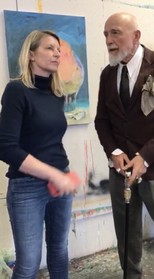Catrin Rothe: Imagination and Expression

Born in Halle, Germany
Education
Study of Arts in Halle at Burg Giebichenstein and Heiligendamm
Study of Fine Arts at Akademie in Kolbermoor
Master Student under Prof.Markus Lüpertz
Exhibitions
Solo Exhibition Ayala Museum in Manila,
Exhibition at the Consulate General of the Federal Republic of Germany, New York
Exhibition at World Financial Center, New York, N.Y.
Gallery Shows:
Jaffe Baker Gallery, Boca Raton, Florida
Bruce R.Lewin Gallery, Soho, New York, N.Y.
Opera Gallery, Paris, New York, N.Y.
Opera Gallery Singapore
Opera Gallery, New York, N.Y.
Majlis Gallery, Dubai
Gallery Duemila, Manila
Gallery Show, Tokio
RAR Gallery Berlin
The polyperspectivistic approach to pictorial space in Catrin Rothe's works places her firmly into a venerable European tradition, a tradition that began before the Renaissance, was interrupted by the artists' enthusiasm for central perspective only to be superseded by other approaches since, at the latest, the advent of Modernism. Especially artists who clad their messages in fantasies and fairy-tale like narratives have a penchant towards varying perspectives (as well as exaggerated ones) in their works.
Mostly her works rely on her own imagination, sometimes they refer to the works of others, but only in a general, an iconographic sense – hardly ever she quotes more or less verbatim. Her settings are fanciful and often like in a fairy tale, with a haunting imagery that occupies the beholders' minds, bringing together in an image what is never seen like that in reality, only dreamt of, both by children and grown-ups alike. We glimpse into a magic world, one behind the looking glass, a world following its own rules and re-interpreting what is usually thought to be common knowledge. Personal and historical myths merge, weaving a scintillating fabric to serve as the backdrop for new explorations of imagination and expression.
And expression is definitively there: Her darkish, brooding, glowing colorism, remotely reminiscent of a glimpse into the eye of a volcano, or the surface of the sun, brings strong emotion into play. Her art is not about a cream-colored Barbie-type world, rather it re-sings songs of innocence and experience, remembering that William Blake also preferred to be strong in expression rather than reticent.
Her rendering of figures sometimes relies on the interplay of linear and planar structures, the lines refusing to be congruent with the outlines of the figures, thus asserting the autonomy of painting. the same holds true even without linear elements, as the flat areas of color hold their own against images of memory what shape an object should possess.
In more recent works the motif has turned more into an occasion for almost autonomous and autonomous painting. The imagery has become more abstract, sometimes the beholder is reminded of, say, a landscape, sometimes there isn't any reference like that left. The colors are floating free, creating their specific pictorial space on their own, basking in the glory of their emotional effects that go straight through our eyes into the center of emotion.
In the images which retain references to the real world, the sketchiness of the execution celebrates the aesthetic of the "inachevé", the unfinished. But unfinished the forms are only with respect to the perfectly adapted real form: As pictorial elements they are very finished, indeed. The arbitrary remains constitute the condensation nuclei we need to trigger our aesthetic experience. The works of Catrin Rothe do, indeed, make a generous offer of such possibilities.
Gerhard Charles Rump
